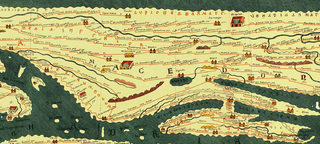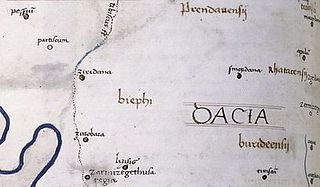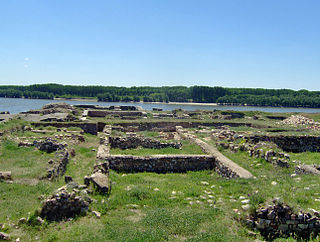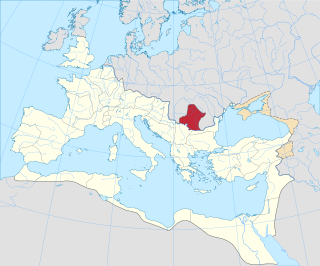
Dacia was the land inhabited by the Dacians, its core in Transylvania, stretching to the Danube in the south, the Black Sea in the east, and the Tisza in the west. The Carpathian Mountains were located in the middle of Dacia. It thus roughly corresponds to present-day Romania, as well as parts of Moldova, Bulgaria, Serbia, Hungary, Slovakia, and Ukraine.
Romula or Malva was an ancient city in Roman Dacia, later the village of Reşca, Dobrosloveni Commune, Olt County, Romania. It was the capital of Dacia Malvensis, one of the three subdivisions of the province of Dacia.

Porolissum was an ancient Roman city in Dacia. Established as a military fort in 106 during Trajan's Dacian Wars, the city quickly grew through trade with the native Dacians and became the capital of the province Dacia Porolissensis in 124. The site is one of the largest and best-preserved archaeological sites in modern-day Romania. It is 8 km away from the modern city of Zalău, in Moigrad-Porolissum village, Mirsid Commune, Sălaj County.

Trajan's Second Dacian War was fought between 105 and 106 because the Dacian king, Decebalus, had broken his peace terms with the Roman Emperor Trajan from the Trajan's First Dacian War.

Argidava was a Dacian fortress town close to the Danube, inhabited and governed by the Albocense. Located in today's Vărădia, Caraș-Severin County, Romania.

Aizis was a Dacian town mentioned by Emperor Trajan in his work Dacica. Located at Dealul Ruieni, Fârliug, Caraș-Severin, Banat, Romania.

Zurobara was a Dacian town located in the northwest of today's Romanian Banat. It was positioned by the Tibiscus (Timiș) river, north of Sarmizegetusa Regia and south of Ziridava.

Amutria was a Dacian town close to the Danube and included in the Roman road network, after the conquest of Dacia.

Capidava was originally an important Geto-Dacian centre on the right bank of the Danube. After the Roman conquest, it became a civil and military centre in the province of Moesia Inferior and part of the defensive frontier system of the Moesian Limes along the Danube.

Piroboridava was a Dacian town mentioned by Ptolemy, and archaeologically identified at Poiana, Galați, Romania. The second part name of the city Dacian dava shows significance of the tribal city.
Rusidava was a Dacian town mentioned in Tabula Peutingeriana between Acidava and Pons Aluti, today's Drăgășani, Vâlcea County, Romania.
Acmonia was a Dacian town mentioned by Ptolemy. near the present town of Zavoi. The Roman fort of Acmonia was nearby.

Ziridava was a Dacian town located between Apulon and Tibiscum, mentioned by Ptolemy in the area of the Dacian tribe of Biephi.

The castra of Aradul Nou was a fort in the Roman province of Dacia, located on the western side of the defensive line of forts, limes Daciae. It is situated near Arad, Romania.

Germisara was a fort in the Roman province of Dacia, in modern day Romania, in the village area of Cigmău, in Romania.

The castra of Târsa was a temporary fort erected by the Romans during the Trajan's Dacian Wars.

Potaissa was a legionary fortress and later a city in the Roman province of Dacia, located in today's Turda, Romania.

Roman Dacia was a province of the Roman Empire from 106 to 271–275 AD. Its territory consisted of what are now the regions of Oltenia, Transylvania and Banat. During Roman rule, it was organized as an imperial province on the borders of the empire. It is estimated that the population of Roman Dacia ranged from 650,000 to 1,200,000. It was conquered by Trajan (98–117) after two campaigns that devastated the Dacian Kingdom of Decebalus. However, the Romans did not occupy its entirety; Crișana, Maramureș, and most of Moldavia remained under the Free Dacians.

















